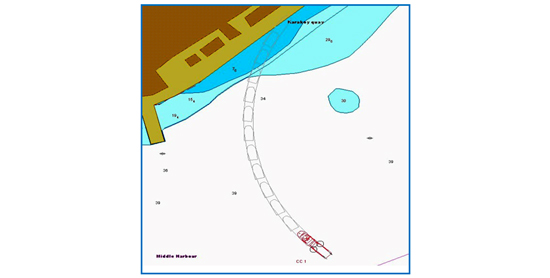Development of automatic control methods of vessel rotation around the pivot point without drift
DOI:
https://doi.org/10.15587/2706-5448.2022.269364Keywords:
navigation safety, control processes optimization, safe separation of vessels, automatic control module, pivot pointAbstract
The object of research is the processes of automatic control of the vessel rotation around the pivot point with zero drift. In recent years, the number of vessels and their sizes has increased significantly, while the size of ports has grown much more slowly. There is an urgent need to optimize control processes, especially in compressed waters. One of the directions of such optimization is the use of the pivot point concept – an alternative vision of the vessel movement during its maneuvering. It is shown that the circulation radius and the position of the vessel on circulation are determined by the pivot point abscissa and ordinate. Linearized models of the two most common control schemes are considered: the control scheme of a single-screw conventional vessel without a bow thruster and the control scheme of a single-screw conventional vessel with a bow thruster. For the steady state of each of these schemes, controls were obtained that ensure the circulation of the vessel around a pivot point position without drift angle. This makes it possible to reduce the width of the traffic lane, increase traffic safety, reduce hydrodynamic resistance and fuel consumption, create favorable conditions for carrying out technological operations, for example, mooring, and reduce the influence of the human factor on control processes. The workability and effectiveness of the developed methods were verified by mathematical modeling of the MSС Container Ship (Dis. 32025t) automatic mooring without drift angle on the imitation modeling stand created by the authors on the basis of the Navi Trainer 5000 navigation simulator. The obtained capabilities are explained by the use of the mathematical model of the vessel in the on-board controller of the automated system and modern mathematical apparatus. The developed methods can be used on the vessels, provided to integration into the existing automated system of an on-board controller with open architecture, to increase the capabilities of automatic vessel movement control. Today, all automated systems already use the electronic principle of generating and transmitting signals from control devices (power plant telegraph, rudder, bow and stern thruster telegraphs and etc.) to executive devices, which greatly simplifies the integration of the on-board controller and the creation of a closed circuit of automatic control.
References
- Seo, S. G. (2011). The Use of Pivot Point in Ship Handling for Safer and More Accurate Ship Manoeuvring. Proceedings of IMLA, 1 (29), 271–280. Available at: https://www.academia.edu/36456506/The_Use_of_Pivot_Point_in_Ship_Handling_for_Safer_and_More_Accurate_Ship_Manoeuvring
- Seo, S.-G. (2016). Safer and More Efficient Ship Handling with the Pivot Point Concept. TransNav, the International Journal on Marine Navigation and Safety of Sea Transportation, 10 (4), 605–612. doi: https://doi.org/10.12716/1001.10.04.09
- Hooyer, H. H. (1983). Behavior and Handling of Ships. Cornell Maritime Press.
- Tzeng, C.-Y. (1998). Analysis of The Pivot Point for a Turning Ship. Journal of Marine Science and Technology, 6 (1), 34–44. doi: https://doi.org/10.51400/2709-6998.2518
- Chase, G. A. (1999). Sailing Vessel Handling and Seamanship – The Moving Pivot Point. The Northern Mariner/Le Marin Du Nord, 9 (3), 53–59. doi: https://doi.org/10.25071/2561-5467.629
- Cauvier, H. (2008). The Pivot Point. The PILOT. The official organ of the United Kingdom Maritime Pilots’ Association, 295. Available at: http://www.pilotmag.co.uk/wp-content/uploads/2008/06/pilotmag-295-final-web.pdf
- Artyszuk, J. (2010). Pivot point in ship manoeuvring. Scientific Journals Maritime University of Szczecin, 20 (92), 13–24.
- Paveliev, A. D. (2010). Determination pivot point position and its consideration when maneuvering the vessel. Volga State Academy of Water Transport, 112.
- Zinchenko, S., Tovstokoryi, O., Nosov, P., Popovych, I., Kyrychenko, K. (2022). Pivot Point position determination and its use for manoeuvring a vessel. Ships and Offshore Structures, 1–7. doi: https://doi.org/10.1080/17445302.2022.2052480
- Zinchenko, S., Mateichuk, V., Nosov, P., Popovych, I., Solovey, O., Mamenko, P., Grosheva, O. (2020). Use of Simulator Equipment for the Development and Testing of Vessel Control Systems. Electrical, Control and Communication Engineering, 16 (2), 58–64. doi: https://doi.org/10.2478/ecce-2020-0009

Downloads
Published
How to Cite
Issue
Section
License
Copyright (c) 2022 Serhii Zinchenko, Oleh Tovstokoryi, Oleksandr Sapronov, Andrii Petrovskyi, Artem Ivanov, Kostiantyn Tymofeiev

This work is licensed under a Creative Commons Attribution 4.0 International License.
The consolidation and conditions for the transfer of copyright (identification of authorship) is carried out in the License Agreement. In particular, the authors reserve the right to the authorship of their manuscript and transfer the first publication of this work to the journal under the terms of the Creative Commons CC BY license. At the same time, they have the right to conclude on their own additional agreements concerning the non-exclusive distribution of the work in the form in which it was published by this journal, but provided that the link to the first publication of the article in this journal is preserved.








